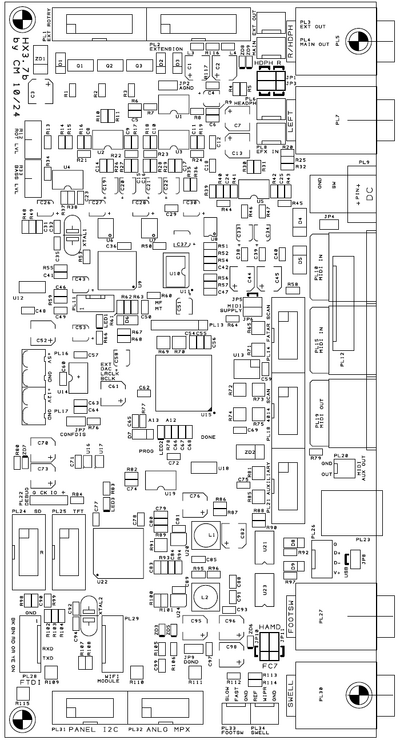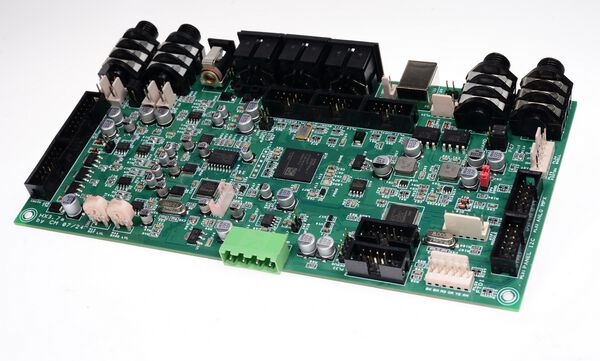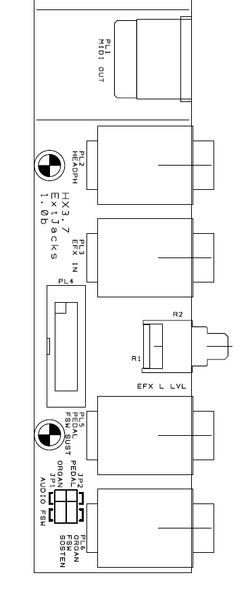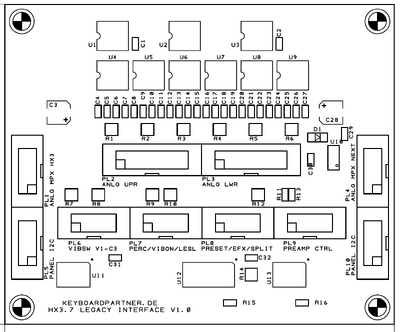HX3.7 Main page: Unterschied zwischen den Versionen
Bovist (Diskussion | Beiträge) |
Bovist (Diskussion | Beiträge) |
||
| (20 dazwischenliegende Versionen desselben Benutzers werden nicht angezeigt) | |||
| Zeile 1: | Zeile 1: | ||
[[Datei:Hx37 mainboard slant.JPG|600px|thumb|right|HX3.7 Mainboard]] | |||
==HX3.7 – Preliminary Draft== | ==HX3.7 – Preliminary Draft== | ||
| Zeile 4: | Zeile 6: | ||
[[Datei:HX37 JackExt.png|250px|thumb|right|HX3.7 JackExtension board]] | [[Datei:HX37 JackExt.png|250px|thumb|right|HX3.7 JackExtension board]] | ||
The improved, highly integrated HX3.7 mainboard will be available by end of 2024. It replaces the current HX3.6 mainboard and should be compatible with most existing installations. It offers 4 channel DACs and better audio amps/filters, full Leslie speaker control circuits and an effects insert loop with additional ADC between internal tube amp and internal rotary simulation. This allows separate use of the rotary simulation for external musical instruments as well. | |||
HX3.7 does no longer offer "legacy" button/switch inputs (like '''Panel16''') and classic analog drawbar inputs (old green '''DB9/DB12''' boards). Instead, it relies on I2C bus interfaces on external panels (like Preset16, Extern16 or VibSw) and analog scanning circuits as found on PTX, ANX, DBX9 and DBX12 drawbar boards. For existing OEM installations, we will offer an interface ('''LegacyBoard''') providing connectors for legacy hardware (see below). | |||
However, we '''strongly recommend''' I2C bus ('''PANEL I2C''' connector, for buttons/switches/LEDs) and MPX bus ('''ANLG MPX''', analog scanning for pots/drawbars) circuitry as this greatly reduces wiring effort. Refer to our DBX, ANX and PTX schematics for MPX bus interfacing (using 74HC164 shift registers and 4066 analog switches) and Preset16/VibSw schematic (using PCA9554A and PCA9555 port devices) for I2C bus interfacing. All newer drawbar boards for HX3.5 and up (colored black) are compatible with HX3.7 ANLG MPX bus. | |||
All older Preset16, Preset12-2 and Extend16 boards are compatible with HX3.7 also, they do not need the LegacyBoard. For connection of a vibrato rotary switch, we offer the small '''VibSw''' board which has its own I2C circuit onboard. It connects to '''PL31 PANEL I2C'''. | |||
See [http://updates.keyboardpartner.de/Files/index.php?dir=Schematics%20%28Schaltbilder%29/HX3.7%20Mainboard '''HX3.7 Schematics Directory'''] for detailed PDF drawings and schematics. | |||
===Common Features with HX3.5/HX3.6=== | ===Common Features with HX3.5/HX3.6=== | ||
| Zeile 18: | Zeile 30: | ||
* No onboard drawbar inputs | * No onboard drawbar inputs | ||
* No onboard button/switch inputs | * No onboard button/switch inputs | ||
* No ExtensionBoard connector (Leslie control and headphone amp circuit integrated on board now) | |||
===Additional Features=== | ===Additional Features=== | ||
| Zeile 33: | Zeile 40: | ||
* Improved DACs and audio amps/filters | * Improved DACs and audio amps/filters | ||
* Insert loop (mono effects insert between tube amp simulation and rotary simulation) | * Insert loop (mono effects insert between tube amp simulation and rotary simulation) | ||
* 3 onboard MIDI connectors (2x IN, 1x OUT) | * 3 onboard MIDI connectors (2x IN, 1x OUT), MIDI OUT may alternatively be mounted on JackExtension | ||
* Onboard audio output jacks may be jumpered as L/R mono jacks '''or''' stereo L/R and stereo headphone jack | * Onboard audio output jacks may be jumpered as L/R mono jacks '''or''' stereo L/R and stereo headphone jack | ||
* Additional output signals and effect loop input available on 16-pin box header '''PL2''' and 3-pin wire-to-board connectors | * Additional output signals and effect loop input available on 16-pin box header '''PL2''' and 3-pin wire-to-board connectors | ||
| Zeile 51: | Zeile 58: | ||
|- | |- | ||
!1 | !1 | ||
|Rotary audio channel, to pin 1 | |Rotary audio channel (organ), to pin 1 | ||
|- | |- | ||
!2, 3, 10 | !2, 3, 10 | ||
|Stationary audio channel, to pin 2 resp. 3 and 10 | |Stationary audio channel (bass pedal), to pin 2 resp. 3 and 10 | ||
|- | |- | ||
!4 | !4 | ||
| Zeile 68: | Zeile 75: | ||
|Fast (MOSFET switches positive voltage to ground), to pin 7 | |Fast (MOSFET switches positive voltage to ground), to pin 7 | ||
|- | |- | ||
! | !8 | ||
|Slow/Run (MOSFET switches positive voltage to ground), to pin 8 | |Slow/Run (MOSFET switches positive voltage to ground), to pin 8 | ||
|- | |- | ||
!11 | !11 | ||
|Leslie +30V supply (clamping), to pin 11 | |Leslie +30V supply (clamping), to pin 11 (optional, may be left open) | ||
|- | |- | ||
!12 | !12 | ||
| Zeile 85: | Zeile 92: | ||
|} | |} | ||
Note: For old 9-pin Leslie installations, small 5V relays may be needed as some Leslie speakers use negative switching voltage. Three 5V relays (common coils to +5V pin) may be driven directly from 11-pin control outputs 6, 7 and 8. | |||
{|class="wikitable" border="1" cellpadding="4" cellspacing="0" style="text-align:left;width: 25%;background-color:#ffffcc;" | {|class="wikitable" border="1" cellpadding="4" cellspacing="0" style="text-align:left;width: 25%;background-color:#ffffcc;" | ||
| Zeile 138: | Zeile 146: | ||
===HX3.7 JackExtension=== | ===HX3.7 JackExtension=== | ||
A small board will be available which makes installation of additional HX3.7 connectors easier. HX3.7 JackExtension will be used in futute 19" rack expander. It replaces the former HX3 ExtensionBoard. HX3.7 JackExtension connects to '''HX3.7 PL2''' and only carries passive/mechanical parts for convenient wiring. For OEM applications, JackExtension may be customized to existing chassis layouts. | A small board will be available which makes installation of additional HX3.7 connectors easier. HX3.7 JackExtension will be used in futute 19" rack expander. It replaces the former HX3 ExtensionBoard. HX3.7 JackExtension connects to '''HX3.7 PL2''' and only carries passive/mechanical parts for convenient wiring. For OEM applications, JackExtension may be customized to existing chassis layouts. A MIDI OUT connector may be mounted here instead of mainboard. | ||
===HX3.7 LegacyBoard=== | ===HX3.7 LegacyBoard=== | ||
| Zeile 144: | Zeile 152: | ||
[[Datei:HX37 legacyboard.png|400px|thumb|right|HX3.7 LegacyBoard dimensions]] | [[Datei:HX37 legacyboard.png|400px|thumb|right|HX3.7 LegacyBoard dimensions]] | ||
As HX3.7 does no longer offer legacy analog and switch inputs, the HX3.7 LegacyBoard will be available to connect existing passive switch/button boards like Panel16 (16 inputs) | As HX3.7 does no longer offer legacy analog and switch inputs, the HX3.7 LegacyBoard will be available to connect existing passive switch/button boards like Panel16 (2x8 = 16 inputs, two 10-pin headers), analog drawbar controls (2x12 = 24 inputs, two 16-pin headers) and a 6-way rotary vibrato switch (10-pin header). The LegacyBoard '''is not needed''' for new installations using the new MPX connector (all DBX/PTX/ANX boards). It connects to HX3.7 '''PL31 PANEL I2C''' and '''PL32 ANLG MPX''' box headers. | ||
<span style="color:red> '''The LegacyBoard is not intended for new OEM designs which should use the I2C and ANLG MPX bus instead.'''</span> | |||
Aktuelle Version vom 13. Oktober 2024, 16:28 Uhr
HX3.7 – Preliminary Draft

The improved, highly integrated HX3.7 mainboard will be available by end of 2024. It replaces the current HX3.6 mainboard and should be compatible with most existing installations. It offers 4 channel DACs and better audio amps/filters, full Leslie speaker control circuits and an effects insert loop with additional ADC between internal tube amp and internal rotary simulation. This allows separate use of the rotary simulation for external musical instruments as well.
HX3.7 does no longer offer "legacy" button/switch inputs (like Panel16) and classic analog drawbar inputs (old green DB9/DB12 boards). Instead, it relies on I2C bus interfaces on external panels (like Preset16, Extern16 or VibSw) and analog scanning circuits as found on PTX, ANX, DBX9 and DBX12 drawbar boards. For existing OEM installations, we will offer an interface (LegacyBoard) providing connectors for legacy hardware (see below).
However, we strongly recommend I2C bus (PANEL I2C connector, for buttons/switches/LEDs) and MPX bus (ANLG MPX, analog scanning for pots/drawbars) circuitry as this greatly reduces wiring effort. Refer to our DBX, ANX and PTX schematics for MPX bus interfacing (using 74HC164 shift registers and 4066 analog switches) and Preset16/VibSw schematic (using PCA9554A and PCA9555 port devices) for I2C bus interfacing. All newer drawbar boards for HX3.5 and up (colored black) are compatible with HX3.7 ANLG MPX bus.
All older Preset16, Preset12-2 and Extend16 boards are compatible with HX3.7 also, they do not need the LegacyBoard. For connection of a vibrato rotary switch, we offer the small VibSw board which has its own I2C circuit onboard. It connects to PL31 PANEL I2C.
See HX3.7 Schematics Directory for detailed PDF drawings and schematics.
Common Features with HX3.5/HX3.6
- Same firmware and same FPGA sound engine
- Same PCB size, same mounting holes
- Same location of DC, USB, audio and MIDI connectors
- MenuPanel/Preset Bus Connector (I2C)
- Analog MPX Bus for newer DBX, PTX and ANX boards
- Auxiliary MIDI out, Fatar scan and pedal scan connectors
Omitted Features
- No onboard drawbar inputs
- No onboard button/switch inputs
- No ExtensionBoard connector (Leslie control and headphone amp circuit integrated on board now)
Additional Features
- All ExtensionBoard features integrated
- Integrated 11-pin Leslie control, ExtensionBoard pinout on 14-pin box header PL1
- Additional DAC, outputs for plain organ and pedal signal, total of 4 audio output channels
- Headphone amp
- Improved DACs and audio amps/filters
- Insert loop (mono effects insert between tube amp simulation and rotary simulation)
- 3 onboard MIDI connectors (2x IN, 1x OUT), MIDI OUT may alternatively be mounted on JackExtension
- Onboard audio output jacks may be jumpered as L/R mono jacks or stereo L/R and stereo headphone jack
- Additional output signals and effect loop input available on 16-pin box header PL2 and 3-pin wire-to-board connectors
- JackExtension PCB available for additional MIDI and audio input/output jacks, same jack location as old extension board
MIDI output jack may be mounted on mainboard (new hole for connector necessary) or custom JackExtension board (old location of MIDI OUT connector) alternatively. Note: JackExtension board may be customized for OEM use as it only contains passive components (jacks, optional level potentiometer).
See HX3.7 Schematics Directory on our Update Server for details.
| PL1 Leslie 11pin Connector | |||||||||
|---|---|---|---|---|---|---|---|---|---|
| Pin | Funktion | ||||||||
| 1 | Rotary audio channel (organ), to pin 1 | ||||||||
| 2, 3, 10 | Stationary audio channel (bass pedal), to pin 2 resp. 3 and 10 | ||||||||
| 4 | Audio ground, to pin 4 | ||||||||
| 5 | Common ground for control signals, to pin 5 | ||||||||
| 6 | Power ON (MOSFET switches positive voltage to ground), to pin 6 | ||||||||
| 7 | Fast (MOSFET switches positive voltage to ground), to pin 7 | ||||||||
| 8 | Slow/Run (MOSFET switches positive voltage to ground), to pin 8 | ||||||||
| 11 | Leslie +30V supply (clamping), to pin 11 (optional, may be left open) | ||||||||
| 12 | Additional analog Gnd output, not connected | ||||||||
| 13 | Additional digital Gnd output, not connected | ||||||||
| 14 | Auxiliary +5V supply output for relays if needed | ||||||||
Note: For old 9-pin Leslie installations, small 5V relays may be needed as some Leslie speakers use negative switching voltage. Three 5V relays (common coils to +5V pin) may be driven directly from 11-pin control outputs 6, 7 and 8.
| PL2 Extension Jacks Connector | |||||||||
|---|---|---|---|---|---|---|---|---|---|
| Pin | Funktion | ||||||||
| 1 | Headphone Left | ||||||||
| 2 | Headphone Right | ||||||||
| 3 | Ext Out L (plain ORGAN signal) | ||||||||
| 4 | Ext Out R (plain PEDAL signal) | ||||||||
| 5 | Ext In L (Effect Loop Input, mixed to mono) | ||||||||
| 6 | Ext In R (Effect Loop Input, mixed to mono) | ||||||||
| 7 | Sustain Footswitch | ||||||||
| 8 | Sostenuto Footswitch | ||||||||
| 9 | MIDI OUT (-, DIN pin 5) | ||||||||
| 10 | MIDI OUT (+, DIN pin 4) | ||||||||
| 11 | Efx Jack Insert Switch (open when inserted, Gnd when not) | ||||||||
| 12 | Vcc +5V | ||||||||
| 13, 14 | Analog Ground | ||||||||
| 15, 16 | Digital Ground | ||||||||
HX3.7 JackExtension
A small board will be available which makes installation of additional HX3.7 connectors easier. HX3.7 JackExtension will be used in futute 19" rack expander. It replaces the former HX3 ExtensionBoard. HX3.7 JackExtension connects to HX3.7 PL2 and only carries passive/mechanical parts for convenient wiring. For OEM applications, JackExtension may be customized to existing chassis layouts. A MIDI OUT connector may be mounted here instead of mainboard.
HX3.7 LegacyBoard
As HX3.7 does no longer offer legacy analog and switch inputs, the HX3.7 LegacyBoard will be available to connect existing passive switch/button boards like Panel16 (2x8 = 16 inputs, two 10-pin headers), analog drawbar controls (2x12 = 24 inputs, two 16-pin headers) and a 6-way rotary vibrato switch (10-pin header). The LegacyBoard is not needed for new installations using the new MPX connector (all DBX/PTX/ANX boards). It connects to HX3.7 PL31 PANEL I2C and PL32 ANLG MPX box headers.
The LegacyBoard is not intended for new OEM designs which should use the I2C and ANLG MPX bus instead.


